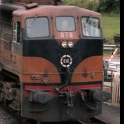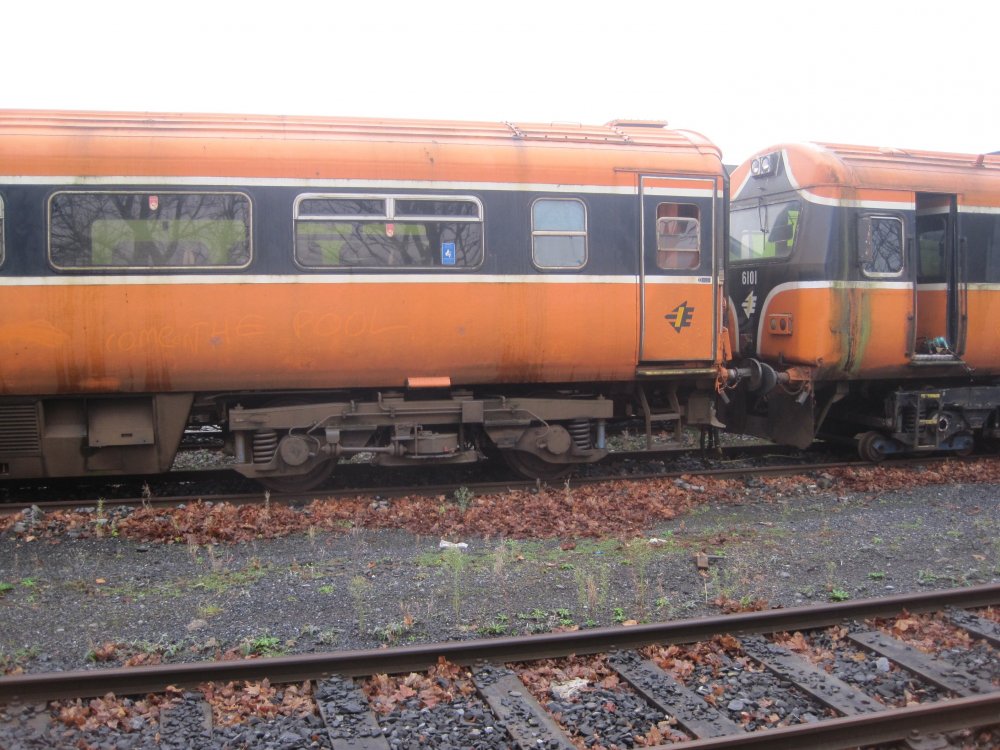-
Posts
412 -
Joined
-
Last visited
Content Type
Profiles
Forums
Resource Library
Events
Gallery
Blogs
Store
Community Map
Posts posted by hexagon789
-
-
On 1/2/2019 at 11:44 PM, Mayner said:
I don't know if there are verified 90+ mph timings for members of the 800 Class or other Irish steam locos.
Irish steam records are mainly based on stopwatch recordings of runs by journalists and enthusiast "timers".
In the steam era there was little need for high speed running in the absence of competing routes apart from Belfast-Londonderry and Belfast-Newcastle, in the South average train speeds were scheduled with relatively low 42.3mph Kingsbridge-Cork, 26.9 mph Kingsbridge Waterford, 33.6mph Broadstone-Galway. The most important trains were the cross-Channel Mails which were heavily loaded and called at all the principal stations, the ordinary all-stations passenger trains were even slower.
The Irish steam record is held by a 1934 non-stop Dublin-Cork special (for the newly appointed American Ambassador) with a recorded average speed of 85.6 mph between Ballybrophy and Portlaoise. 402 may have reached or exceeded 90 at some stage between the two stations. Cecil J. Allen a British railway journalist appears to have been invited by the GSR to record the run. average speed exceeded 70mph between Limerick Junction and Kingsbridge.
The loco was 402 a 2 cylinder 4-6-0 driven by Mark Foley with 3 coaches (95 tons gross). 402 was considered to be the best of the rebuilt 400 Class similar in capability to a GWR Saint or Southern King Arthur.
800 is reported to have achieved 92mph during a demonstration run in July 1939
There is a log of a run of 800 on an up Cork Mail between Portlaoise and Kingsbridge in Aug 1939 with 450 Tons in O.S. Nocks Irish Steam with a maximum recorded speed of 76.5 mph at Hazlehatch. O S Nock was particularly impressed with 800s acceleration on the climb out of Cork but the crew ran into problems with a sticking regulator valve near the top of the bank out of Cork and a patch of poor quality coal during the middle of the journey.
A number of 001 Class were uprated to 1650hp this was to ensure that certain trains including Heuston-Tralee passenger trains could keep time within the existing line limits of 70mph on the Dublin-Cork line and 60mph Mallow-Tralee lines.
Thank you for the reply, interesting to read that it wasn't only the '800s' capable of higher speeds.
I can understand the uprating of the 001s for that reason then.
Does this also mean that Dublin-Cork was never higher than 70 pre-war then?
-
I was discussing Maedh with a friend and how she managed I think it was 96mph and sister Tailté 95mph and I mentioned that the linespeed on the Dublin-Cork was 70mph in the post-war period and that together with coal shortages and subsequent dieselisation meant the 800s never really got a chance to show their true potential as such.
Anyway, he commented that it was strange that the GSR imposed a 70mph limit when their locos could do 95, and I said well the 70 limit came first surely, then I recalled an article about Ireland's early diesels which gave some mention of the sort of timings one had in the '50s and I noticed this sentence:
"The Dublin-Cork double track mainline, 165.3 miles long, and which, although well engineered, in the post-war period had an overall 70 mph speed limit imposed."
Maybe I'm over-reading it but the word 'imposed' suggests it may once gave been higher?
So to my point - was the limit on the Dublin-Cork higher than 70 pre-war, and if so what was it? I'm thinking 75 possibly 80, my friend thought 90 but I think that's too high.
Of course when one starts with one simple question, it quickly morphs into a whole heap of questions and so I'd be very grateful if someone could answer any of the following:
1. The maximum on the Dublin-Cork pre-war
2. When and why it was raised to 75
3. When it was raised to 90
4. When it was raised to 100 (I believe May 1995 but I cannot find where I got that date from)
5. Were the Mk2Ds ever permitted higher than 75? The Harris book on Mark 2 coaches suggests they were introduced running at 80mph on Dublin-Cork on a 2.5 hour timing, I don't know whether this was simply the plan or if it actually happened.
6. The actual service maximum for a 121, I've seen 77mph quoted by some sources, 75 by others. 75 seems logical to me, 77 more liked the maximum the gearing will allow.
7. The actual service maximum for a 141, I've seen 75, 76 and 80
8. The actual service maximum for a 181, I've seen 75 and 80 service as well as a design maximum of 89?
9. The maximum for a 001 'A' Class, books suggest 75 for all originally biut some had the traction motors rewound and were uprated to 80mph for the 'Enterprise'? I thought that the Mk2 stock and indeed the Dublin-Belfast mainline was 70 maximum until the De-Dietrichs were introduced in the early '90s.
10. I therefore assume that the 071s were unable to 'officially' run at 90 until the Mk3s were introduced and whenever the Dublin-Cork mainline was upgraded for 90mph running?
Thank you for you patience with this horrendously long-winded post and thanks for any replies.
Regards, Ben

-
-
At long last the article is almost finished, however a couple of other questions have arisen in the interim. They aren't really related to internal layout but as they are to do with the Mk3s it seemed logical to add them to this thread.
1. When and what was the first service run with Mk3 stock?
2. When were the Mk3s permitted to run at 100 mph as opposed to 90 mph?
3. What type/types of Wheel Slide Protection were they fitted with?
BR Mk3s were fitted with one of two systems originally. The prototype vehicles, Mk3a LHCS and early production HST trailers were equipped with a Girling-designed WSP system. The remainder of, and indeed majority, of HST trailers, all Mk3 sleepers and the Mk3b LHCS were equipped with a British Rail-designed WSP. Some have been fitted with a more modern system from Knorr Bremse since privitisation but both orginal systems remain in use.
I assume the IÉ Mk3s had either the Girling or BR system or possibly both were used depending on batch/vehicles type unfortunately I can't find out which system(s) was used and decent quality photos of bogies are proving elusive.
Thanks for any replies.
-
Thanks for the reply, the formations are very helpful. 2007/8 formations woukd be welcome too if it's not too much trouble.
-
I've come up with a few more questions I'm afraid! When were the Composites reseated from 16F/52S to 32F/36S and is there a particular reason why in the original full Firsts (7107, 7110, 7157) and the Composites that IÉ settled on 2+2 seating when both the Mk2d First Class and that of British Mk3s was 2+1? And why were the CityGold vehicles converted? Was it decided that the 2+2 Full Firsts weren't really suited to Business traffic or something? Thanks for any answers/ideas, regards Ben.
-
I can PM or e-mail you the article if you like, whichever is more convenient. Be warned it's my first article so it's rather long and wordy! I can also give you a fairly exhaustive list of formations to go with it as well if you care for it.
-
That's immensely helpful hurricanemk1c as are the formations. Thanks a lot, the reseating in 2007 makes a lot more sense to the other arrangements I've found.
Was 7147 used on specific services because of its status a a Disabled Standard or just as any other Standard?
Seems a bit strange that 7107 was converted from 64-seat First to 72-seat (36/36) Composite to 64-seat Standard.
And thank you for including Mk2d formations as well, that helps with the Mk2d bit if the article.
-
It's primarily for a group of friend who are interested in railways, I've already done an article on the British Rail ScotRail 47/7 push-pulls, but I do plan to make the article available online at some point.
I've being doing a bit more research and I got another vehicle to add to the mixture 7110, I'm curious as to whether this vehicle was converted from its original 64-seat full First layout to a 72-seat Standard as several sources suggest or whether it remaimed a 64-seat possibly declassified First like 7107 and 7157 seem to have.
The trouble is for ages you can't find any information then when you find lots of information it all conflicts with each other, c'est la vie I guess.
But thanks to all those who have replied so far, the photos of 7107, 7147 and 7157 are both helpful and interesting but I'm now even more confused as 7107 seems to have possibly remained a 64-seat full First?
I'm still hopeful someone can perhaps explain it all and what actually was the arrangement for these 4 vehicles in 2004.
EDIT: just seen the above post, I started typing this reply before it was posted but I'll leave it up as is with this edit for clarification.
-
That would be great, thanks. I did did think that the Executives were reserved for specials and the like but also wondered about the operationall convenience of having two coaches that were used only on occasion, but your comment helps confirm what I previously thought.
-
I'm currently compiling a list of Irish Coaching Stock for use in any article I'm planning to right and while I've had no real issues with the Mk2d stock I've found a few discrepancies with certain Mk3 vehicles that I'm hoping someone can clear up for me.
For reference I'm looking for the state of the following vehicles in about 2004:
7107 - was this an Open Composite seating 36F/36S or an Open Standard seating 64?
7147 - was this an Open Standard seating 72, 66 or 64 plus a wheelchair space?
7157 - was this an Open First seating 64 or an Open Standard seating 64?
Additionally I'm curious as to how the two Executive Mk3s were used. I believe they were used in specials and so-called "Executive" trains but I assume they were also used in normal service trains? If so what services were they typically used in and as which type of vehicle, I've seen reference to 7162 being used as a dining car, is this when used in Executive trains or in lieu of a CityGold vehicle or something?
Finally I've got a vague idea of how the seats were generally formed but if someone could let me know if the following is broadly correct:
Dublin-Cork CityGold services: Typically Generator Van-CityGold-Buffet-5/6 Standards
Other Dublin-Cork: Typically Generator Van-Composite-Buffet-4/5 Standards
Dublin-Galway/Waterford/Tralee/some Limerick services: Typically Generator Van-Composite-Buffet-4/5 Standards
Dublin-Westport: Typically Generator Van-Standard-Buffet-3 Standards
Thanks in advance for any answers or clarifications anyone can give.
Regards, Ben
.png.c363cdf5c3fb7955cd92a55eb6dbbae0.png)




Historic Linespeeds on Irish railways.
in Questions & Answers
Posted
Indeed, some appear to have been very slow.
Interesting, are they still the only Class to have had speedometers or do locos operating on the mainline require them now?